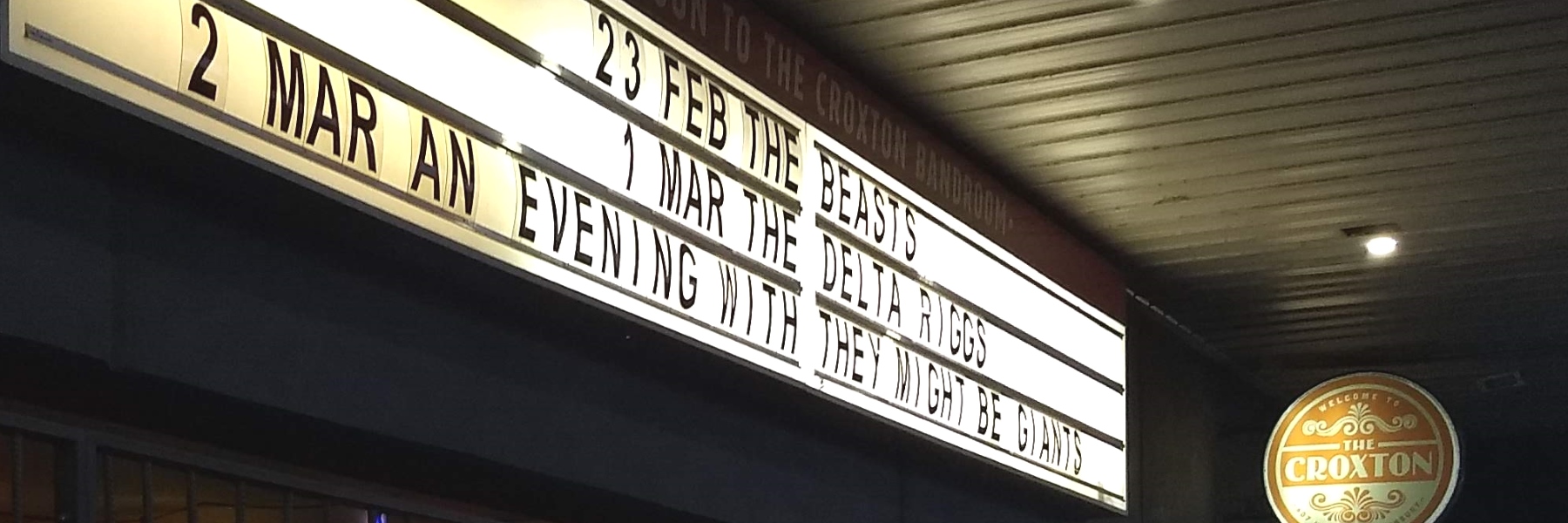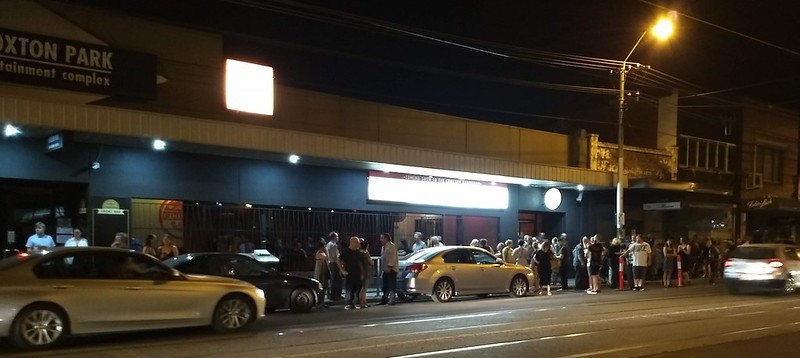On Saturday night at the Croxton Bandroom we saw They Might Be Giants playing a 1990s vs 2000s concert. The night before they’d done a 1980s vs 2010s concert.
It was great stuff, very enjoyable.
Now that I’ve heard Instanbul, Doctor Worm and Birdhouse In Your Soul live, I can die a happy man. And there were lots of other great songs – here’s a full set list. I particularly loved Man It’s So Loud In Here.
This great pic from last night’s fantastic @tmbg gig by @richard_annable pic.twitter.com/qdSGrZiVVH
— Daniel Bowen (@danielbowen) March 2, 2019
Obligatory transport content
The last time I went to an inner-north pub gig, we took public transport. This time we drove.
This was partly driving practice for my son on L plates, and partly because an earlier destination that afternoon would have involved bustitution.
Heading home from Croxton back to Bentleigh in the car took about 40 minutes, with little traffic apart from on some sections of Hoddle Street.
Google Maps tells me that by train it would have taken 56 minutes (including a 13 minute interchange at Flinders Street, which isn’t terrible, but isn’t terrific either) plus a short walk at each end.
A couple of observations on that:
- Google Maps’ estimate for the car journey, leaving at 11:40pm, is 24 to 55 minutes. I’m not sure 24 would ever be achievable, but it’s not hard to see how it could be a very long trip if there was an event at the MCG/sports precinct.
- Even at times of relatively light traffic, train can be reasonably competitive with driving in Melbourne, particularly on trips with no freeways – but it’s really pot luck on wait times, especially for trips involving interchange between lines.
- Quick interchange helps make public transport trips quicker. Changing trains could take up to 30 minutes in the evening, or even 60 minutes after 1am on weekends. Higher frequencies make for quick interchanges, and mean PT is viable for far more combinations of trip start and end points – not just the places that a single route serves.
Trains every 20 minutes in daytime, and every 30 minutes after 7:30pm is completely inadequate for a city of Melbourne’s size. Fixing it would not be expensive because the infrastructure and the fleet is readily available.
Sydney is now at 71% of stations with a train at least every 15 minutes until 11pm. It’s time Melbourne caught up.


14 replies on “TMBG – and crosstown trips”
I don’t see how a trip which took 40 minutes by car, could ever be 56 minutes by train. You must have driven the wrong way, or something.
Train trips always take a long time, because the trains keep stopping.
Also pretty notable in Sydney is the frequent service is *first* to last train as well. Like as an example, the East Hills/Airport line on a weekend morning (both Saturday *and* Sunday) has trains leaving Macarthur, which is 50km from the CBD, every 15 minutes from 3:43am onwards.
You can either laugh or cry at how bad the service in Melbourne is at those times (especially on Sunday) in comparison.
Re Enno:
That particular route does not have any expressways nor freeways of any note. Only the slow and traffic lighted Punt/Hoddle along with others.
I dont know what other way(s) would be better to drive between Bentleigh and Croxton.
On the other side, it would be an almost direct line between Bentleigh and Croxton. Just a small diversion into Flinders Street for a quick change there.
Depending on which directions your trains go around the loop and how fast a walker you are, a left-field shortcut could be to walk between Richmond and West Richmond stations (or catching the 246 I guess, but the chances of this being feasible would be highly unlikely).
@L2, yep good point!
@Nick, when I was at school, some of my classmates would catch trains from South Yarra to the Clifton Hill lines. Depending on timing, they’d hop off at Richmond and run up the hill – I think to West Richmond – to catch a train they’d miss if they went to Flinders Street.
The chances of catching a train that would be missed at Flinders St, at West Richmond have been dramatically reduced by no longer running the Clifton Hill Loop anti-clockwise, eliminating several minutes from the time taken between Flinders St and West Richmond at the times that they used to run anti-clockwise.
Conversely, there may have been an increase in the chance of a West Richmond to Richmond transfer allowing an earlier connecting train, due to the longer trip West Richmond-Flinders St. However this would mostly not be on weekends as the Burnley and Northern groups go clockwise on weekends (and respectively weekday pm and am) and that allows a double change (Parliament and Richmond or Flinders St) that is likely to save enough time (low evening and morning frequencies permitting).
@Tom, this was in the afternoons, when those trains ran clockwise around the Loop.
Interesting arrangement to get home from the pub.
I presume both the L-plater and the instructing driver drank orange juice all night!
Is it practical to split the trains in two and run at twice the frequency? Other than the manpower issue?
@roger, we’re not big drinkers in my family, but it turns out that the L-plater has to have zero blood-alcohol, but the instructor can be up to 0.05 !
@Leo, splitting up trains and joining them back together later introduces some issues. It’s possible, of course, but for most public transport the cost of the driver is a substantial factor, so there may be not much to gain… Also note that existing crowding at most off-peak times means the additional patronage gained from cutting waiting times would probably need the long trains anyway.
I have had to cut back my trips out to see live music now I am living out near Werribee. Not that they cost a lot of money, just I don’t want to be getting home at 12am during the week and 2am on weekends. Going into the city and then out is what takes up the time. The last time I had gigs on two concurrent nights I ended up getting an AirBnB to save going backwards and forwards.
I had a look at the Google timings, and the train was very competitive if you drove from Croxton to Bentleigh but made a detour via Flinders Street Station!
Two “low hanging fruit” of train timetable improvement would be short services to fill a 10-minute frequency on the Sunbury line as far as West Footscray (when the the turnback platform is being installed as part of Melbourne Metro Rail), and on the Craigieburn line as far as Essendon. Each would take only 2 extra trains in service to increase from the present service every 20 minutes 9-4 on weekdays, to a 10 minute service, but would deliver enormous improvements in connection with trams, trains and buses.
Footscray has the highest patronage on the network outside of the city loop, because of its connections to buses a tram and a university, and Vline. It would make operation of these bus routes much more cost-effective to lock into a 10-minute train frequency rather than a 20-minute frequency. Essendon is one of the other major bus and tram connection stations in western Melbourne, and the inner stations between Essendon and the city appear to have about half the total patronage of the Craigieburn line, and those with the greatest potential to grow patronage in response to higher daytime frequencies.
Ideally these 10-minute service should be extended as far as Watergardens and Broadmeadows later, but these would provide the greatest return on investment.
@Malcolm, I like your thinking in terms of cheap incremental upgrades, though I wouldn’t do the Sunbury line only as far as West Footscray, as it would really only benefit that station, given Footscray itself already has 6-12 trains per hour during daytime, including weekends.
If making that sort of upgrade, Coburg (Upfield line) might be a good choice, or perhaps one of the Clifton Hill lines.